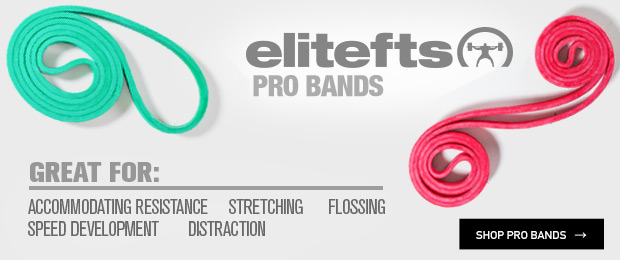
"Strength is a measure of time, not weight."
Louie Simmons
Prom season will be here before we know it! At the U, prom season is that time of year when the PRs drop the most! One method that gives our track athletes a big boost in PR droppage is timed squats. We adopted this method from Louie Simmons after I heard him talk about it in an interview.
The concept is simple, the runner who decelerates the least wins the race. By this logic, you'd better be able to stay strong for the amount of time it takes to run your race.
The first year we ran this, we took a small percentage of the athletes' 1RM and had them perform box squats with chains for the time it took them to run their event.
The following year we modified this setup and did it on the belt squat machine with a box vs. a doubled mini band. All athletes were required to perform a proper box squat. Sit as fast as you can under control, do not slam on the box, pause, then explode up as hard and fast as possible while getting as many reps in their prescribed time as possible. You can increase the load each week or have the athlete attempt to get more reps in the allotted time. We did both. The reps should be fast and crisp. If there is any slowing down, it should be toward the very end of the set.
#136 Mike Tuchscherer | Reactive Training Systems, RPE Programming
Initially, we put this in the max effort lane instead of the max effort movement. The feedback I was getting indicated that while the athletes ran PRs consistently, they still felt like they were losing strength.
Based on this feedback, we reinstated the max effort work the following year, then did the timed belt squat work as their second barbell movement (supplemental lift) when we acquired another belt squat machine to get the groups through their sets.
The year we did the max effort and timed work, we had the most regional qualifiers in school history.
Many coaches trash the max effort method, but there is something to be said for keeping it in the training if your situation allows it. If possible, I would keep your max effort or heavy work in the program while implementing these.
Also, remember that your athletes had better have a high level of training preparedness before you put these in. They can be extremely taxing. Keep an eye on your accessory lift volume and monitor your athletes closely. You can't run these all year long. Start them about eight to ten weeks out from the athlete's big event. I started them eight to ten weeks out from the conference. If an athlete made it to regionals or nationals, it was pretty easy to keep these in for an extended time and pay attention to the athlete's recovery and training volume.
Max Effort Lower Day
Below is what a typical Max Effort Lower day would look like while we ran the timed squats.
- Tissue Prep Lane
- Warm-up Lane
- Jumps Lane
- Max Effort Lane – No technical breakdowns on max effort movement
- Timed Squats
- Accessory Lane
- Mobility/Roll-out Lane
Here is how we broke down the timed squats by event.
Do NOT forget; these weights were in addition to a quadded mini band on the belt squat carriage. See the video below the table for setup instructions.
| Event | Time (Men) | Weight (Men) | Time (Women) | Weight (Women) | Sets |
| 100M | 11s | 50 pounds | 13s | 30 pounds | 3 |
| 200M | 22s | 40 pounds | 24s | 20 pounds | 2-3 |
| 400M | 50s | 30 pounds | 60s | 10 pounds | 1-2 |
| 800M | 120s | 20 pounds | 130s | 10 pounds | 1 |
| 110M Hurdles | 15s | 40 pounds | 15s | 20 pounds | 2-3 |
| 400M Hurdles | 55s | 30 pounds | 60s | 10 pounds | 1 |
Weekly Schedule
Monday: Max Effort Lower
Tuesday: Max Effort Upper
Thursday: Dynamic Effort Lower
Friday: Dynamic Effort Upper
If the team traveled on a Friday, we would sometimes do a combined Dynamic Lower and Upper on Thursday.
Band Setup
Timed Squat Cues
When doing your timed squats, use all the lower body cues from your box squat training.
Taken from "ConjugateU"
Squat Descent
- Hips back hard.
- Knees out hard.
- Push stomach and knees out until you are on the box.
- Pause on the box.
- Maintain pressure out on feet.
Squat Ascent
- Once we get this, many other things seem to fall into place.
- Start to see some snap off the box.
- As long as the knees and pressure stay out, which usually does, the glutes and hips activate properly to stress the hips, glutes, and hamstrings.
These will be your main verbal ques.
"Back and Open"
Hips back, knees open until you're on the box. Many people won't open through the whole descent. The result is usually dropping onto the box instead of keeping tension in the glutes and hamstrings. This can even be shortened to "Open."
"Stomach Out, Knees Out"
Pushing your stomach out will usually keep your back arched and stomach tight.
"Push Out" – The athlete should drive out on their feet to stand up.
"Fast" – Stand up fast!
"Pause" – Make sure they still pause on the box.
You will likely find yourself saying "Open, Push out" around one thousand times a day during this cycle if you are coaching correctly.
There you have it. Plug these in and watch the PRs drop.
If you have any questions feel free to email me at nharvey@elitefts.net.
Image credit: spotpoint74 © 123rf.com
Nate Harvey, MS, CSCS, is elitefts' executive equipment specialist. Nate developed his vast athletic history as the former head strength coach of Olympic sports at The State University of New York at Buffalo. During his 10 years at UB, he coached their first-ever national champion (shot put), four team conference champions (one back-to-back), eight of the school's twelve total All-Americans, 18 Olympic trial qualifiers, over 50 individual conference champions, 16 individual national qualifiers, and over 75 individual regional qualifiers using the conjugate method. He is also a strength and conditioning consultant for the New York Jets. His best lifts are a 1,000-pound squat, a 750-pound bench, and a 750-pound deadlift.











-JG